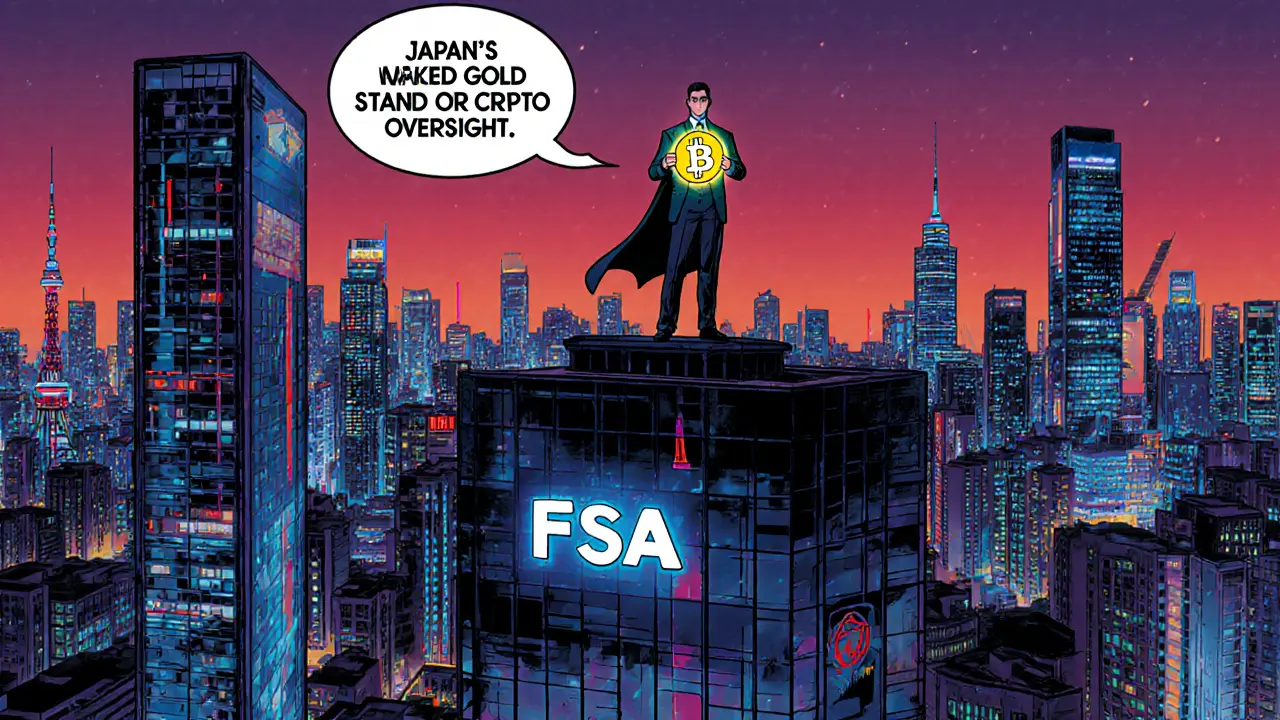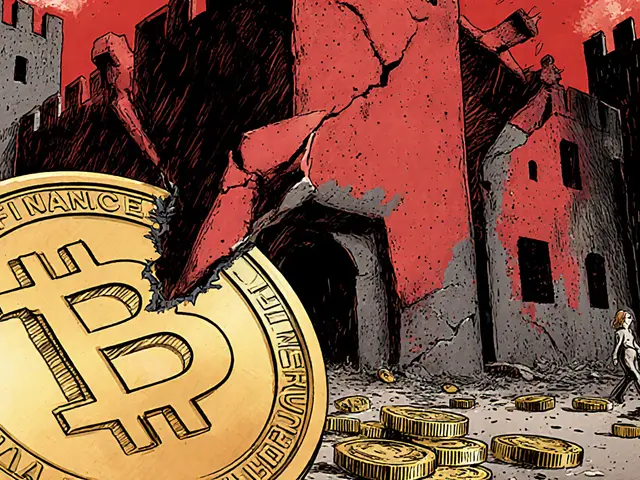Japan's Cryptocurrency Regulation Model: How the FSA Shapes the Crypto Landscape
When you hear "Japan" and "cryptocurrency" together, the first thing that comes to mind is a regulatory system that actually works. Since 2017 the country has built a two‑tiered legal structure that forces exchanges to play by clear rules, protects users with cold‑storage mandates, and even taxes crypto gains at rates that can reach 55%. If you’re a trader, an exchange looking to expand, or just curious about why Japan is often called the gold standard for crypto oversight, this article walks you through every moving part of the model.
What the regulatory model looks like
The backbone of Japan’s approach is the Financial Services Agency (FSA), the country’s primary financial watchdog. The FSA runs a Japan cryptocurrency regulation framework that splits responsibilities between two statutes:
- Payment Services Act (PSA) - governs crypto‑asset exchange service providers, consumer protection, and AML/KYC requirements.
- Financial Instruments and Exchange Act (FIEA) - treats tokens that look like securities as traditional securities, adding disclosure and market‑conduct rules.
This dual‑framework lets the government apply granular rules where they fit best while keeping the overall system coherent.
Payment Services Act: The first line of defense
Under the PSA, any business that wants to run a crypto exchange in Japan must become a crypto‑asset exchange service provider (CAESP). The registration process is rigorous:
- Establish a physical office in Japan - a real address, not just a virtual mailbox.
- Submit a detailed business plan, financial projections, and proof of capital reserves (usually several hundred million yen).
- Implement a full‑blown AML/KYC system that screens every user against sanctions lists.
- Segregate customer funds from operating capital and keep at least 95% of user assets in offline cold storage.
The entire registration can take 6‑12 months, and the FSA conducts periodic on‑site inspections to make sure the rules stay intact.
Financial Instruments and Exchange Act: When tokens become securities
Originally, the FIEA dealt only with stocks, bonds, and derivatives. In July2025 the FSA announced a major shift: tokens that have investment‑like features - such as voting rights, profit‑sharing, or expectations of capital appreciation - will fall under the FIEA. The impact is three‑fold:
- Issuers must publish a prospectus that meets the same standards as a traditional IPO.
- Insider‑trading rules and market‑conduct provisions apply, meaning wash‑trading or pump‑and‑dump schemes are explicitly illegal.
- Regulated crypto‑ETF products, including spot Bitcoin funds, can finally launch on Japanese exchanges with the same legal certainty as equity ETFs.
The transition is slated for early2026, but the FSA is already publishing draft guidelines and holding workshops for industry players.

Taxation: The double‑edged sword
Japan taxes crypto gains as “miscellaneous income,” which can push the effective rate to as high as 55% for high‑income earners. That’s a stark contrast to Germany’s tax‑free threshold after one year or Singapore’s zero‑tax stance. The high rate has sparked a wave of capital‑flight, with many investors moving to more tax‑friendly jurisdictions.
However, the government is eyeing reform. A proposal under review would cap crypto tax at a flat 20% and introduce a three‑year loss‑carry‑forward rule. If passed, the change could double the number of active traders within a year.
Compliance costs and practical challenges
Running a compliant crypto business in Japan is not cheap. Apart from the capital reserve requirement, firms need to invest in:
- Dedicated AML/KYC software that can parse Japanese language documents.
- Cold‑wallet infrastructure that meets the 95% offline storage rule.
- Legal counsel fluent in Japanese financial law - most official guidance is only published in Japanese.
These costs can easily exceed $5million for a mid‑size exchange, which explains why the market is dominated by established domestic players.
How Japan compares with other major jurisdictions
| Aspect | Japan | United States | EU (MiCA) | Singapore |
|---|---|---|---|---|
| Primary regulator | FSA | SEC, CFTC, State regulators | European Commission & National regulators | Monetary Authority of Singapore (MAS) |
| Legal basis for exchanges | Payment Services Act (registration) | Varies by state; often no clear licensing | MiCA licensing for crypto‑asset service providers | Payment Services Act (PSA) & MAS guidelines |
| Token classification | PSA for utility tokens, FIEA for securities‑like tokens | SEC tests for securities; no uniform rule | MiCA defines “asset‑referenced tokens” and “e‑money tokens” | MAS uses a three‑tiered approach (payment, securities, utility) |
| Cold‑storage requirement | ≥95% offline | None mandated federally | Recommended but not required | No explicit percentage |
| Tax on gains | Up to 55%, proposal for 20% flat | Capital gains tax (varies by state) | Taxable as income in member states | Income tax applies; no capital‑gains tax for individuals |
The table shows why many analysts call Japan’s model “the most advanced but also the most demanding.” The clarity gives businesses confidence; the cost barriers can throttle rapid innovation.

What the future holds
The FSA’s shift to the FIEA signals a maturing market where crypto is seen less as a novelty and more as a mainstream investment class. Three trends are likely to define the next few years:
- Regulated crypto ETFs - Spot Bitcoin and Ethereum funds could launch once the FIEA draft is finalized, attracting institutional capital.
- DeFi oversight - The FSA’s DeFi Study Group meets every couple of months to draft sandbox rules for decentralized lending and AMM protocols.
- Tax reform - If the flat‑20% proposal passes, retail participation could surge, narrowing the gap with countries that already enjoy low tax rates.
All of this hinges on the ability of regulators to keep pace with tech while preserving the consumer‑protection ethos that made Japan a model in the first place.
Practical takeaways for businesses and investors
- For exchanges: Expect a 6‑12 month registration timeline, allocate budget for Japanese‑language compliance staff, and invest heavily in cold‑storage solutions.
- For token issuers: Determine early whether your token falls under the PSA or the FIEA. If it has any profit‑sharing feature, prepare a full prospectus and insider‑trading policies.
- For individual investors: Keep accurate records of every purchase, sale, and exchange to simplify tax reporting. Consider the upcoming tax reforms when planning long‑term holdings.
By aligning with Japan’s regulatory expectations, you not only avoid penalties but also tap into a market that handles over 5trillion yen in crypto deposits - a figure that dwarfs many Western exchanges.
Frequently Asked Questions
Do I need a physical office in Japan to run a crypto exchange?
Yes. The Payment Services Act requires every CAESP to maintain a tangible office address within Japan. Virtual offices or mailbox services do not satisfy the regulatory criteria.
How does the cold‑storage rule work?
At least 95% of customer assets must be stored offline in hardware wallets or vaults that are not connected to the internet. The remaining 5% can be kept in hot wallets for daily trading needs, but both portions must be segregated from the exchange’s operating funds.
When will crypto‑ETF products be allowed?
The FIEA draft, expected to become law in early 2026, includes provisions for regulated crypto‑ETF listings. Once the law is enacted, exchanges can apply for approval, provided they meet the same disclosure standards as traditional ETFs.
Is there any benefit to registering in Japan despite high taxes?
The main advantage is credibility. Registration with the FSA signals strong compliance, which attracts institutional investors and partners. Many global firms accept the higher tax burden as a trade‑off for operating in a legally clear environment.
What resources are available for foreign firms navigating Japanese rules?
The FSA offers regular consultation sessions and publishes guidance documents (mostly in Japanese). Engaging a local legal partner familiar with the PSA and FIEA is the most practical way to bridge the language and regulatory gap.






24 Comments
Debra Sears
October 7 2025Japan’s licensing maze can be intimidating, but the payoff is a market where users actually feel protected. The requirement for a physical office and the cold‑storage rule weeds out fly‑by‑night operators. For a trader, that means less chance of disappearing with your funds. It’s a solid reason why many see Japan as a safe harbor for crypto activity.
Sal Sam
October 7 2025The PSA‑FIEA bifurcation imposes a compliance stack that rivals traditional securities frameworks. Entities must allocate multi‑million yen reserves, integrate AML/KYC pipelines capable of parsing Japanese characters, and sustain a 95 % offline custody ratio. From a risk‑management perspective, those controls translate into a lower probability of systemic breach, albeit at a steep operational cost. In short, the regulatory overhead is the price of regulatory certainty.
Lara Decker
October 8 2025The tax ceiling of 55 % effectively pushes high‑income earners toward offshore jurisdictions, undermining the very consumer‑protection goals the FSA touts. While the draft 20 % flat rate is a step forward, the current regime cannibalizes domestic liquidity.
Anna Engel
October 9 2025Oh sure, “gold standard” until you factor in the capital‑intensive entry barrier-if you have $5 million spare, great; otherwise, enjoy watching the domestic giants monopolize the market.
manika nathaemploy
October 9 2025i get that the cold storage thing sounds scary but it actually keeps ur coin safe from hackz lol. also having a real office makes it feel more legit.
Marcus Henderson
October 10 2025It is commendable that the FSA has instituted such a rigorous framework, thereby fostering investor confidence. By mandating segregation of client assets and extensive AML procedures, the agency sets a benchmark for regulatory excellence. Institutions seeking stability should view Japan's model as a prototype for future legislative endeavors.
Andrew Lin
October 10 2025Only Japan dares to be this tough, while other countries just make up rules on the fly. If you’re not willing to throw cash at compliance, stay home. This is why we need strong national policies that protect our investors from reckless foreign schemes.
Brian Lisk
October 11 2025Japan’s two‑tiered approach, anchored by the PSA for exchanges and the FIEA for securities‑like tokens, creates a granular yet cohesive regulatory environment. First, the PSA forces every crypto‑asset exchange service provider to obtain a licence, maintain a physical presence, and hold a substantial capital reserve, which dramatically reduces the risk of fraud. Second, the FIEA’s extension to token offerings means that any asset with profit‑sharing features must comply with the same disclosure and insider‑trading rules as traditional securities, providing a clear legal pathway for legitimate projects. The 95 % cold‑storage mandate, while costly, serves as a powerful deterrent against hacking incidents, ensuring that the majority of user funds remain offline. Moreover, the periodic on‑site inspections conducted by the FSA act as an ongoing compliance check, rather than a one‑off approval. The clear registration timeline of six to twelve months, while lengthy, offers predictability for businesses planning market entry. Companies must also invest in Japanese‑language AML/KYC solutions, which adds another layer of operational complexity but also ensures alignment with local legal standards. Legal counsel versed in both PSA and FIEA is indispensable, as the statutes are published primarily in Japanese, creating a language barrier for foreign firms. The financial outlay-often exceeding $5 million for a midsize exchange-explains why the domestic market is dominated by established players with deep pockets. Nevertheless, the regulatory certainty afforded by the FSA’s framework attracts institutional investors who prioritize compliance and risk mitigation. As the FIEA draft progresses toward early‑2026 implementation, we can expect a wave of regulated crypto‑ETF products, further integrating digital assets into mainstream finance. This evolution underscores the importance of a balanced approach that safeguards consumers while fostering innovation. In sum, Japan’s model exemplifies how stringent oversight can coexist with market growth, provided participants are willing to meet the associated cost and operational demands.
Patrick Gullion
October 11 2025Even if the cost seems high, the long‑term stability it offers could outweigh the initial outlay for many firms.
Jack Stiles
October 12 2025yeah, i feel ya on the monopoly vibe-while the rules keep scams out, they also make it tough for fresh startups to get a foot in the door.
Ritu Srivastava
October 13 2025It’s irresponsible for regulators to ignore the moral imperative of protecting everyday investors from predatory tax regimes.
Darren Belisle
October 13 2025Indeed, the compliance stack is formidable; however, the systematic oversight it creates can be a catalyst for fostering global best practices-if firms can muster the necessary resources.
Heather Zappella
October 14 2025For developers eyeing the Japanese market, partnering with a local legal firm that specializes in PSA and FIEA compliance is often the most pragmatic step. This not only ensures adherence to capital‑reserve requirements but also streamlines the process of translating AML/KYC documentation into Japanese. Additionally, leveraging existing Japanese custodial providers can help meet the 95 % offline storage benchmark without building in‑house infrastructure from scratch.
Kate O'Brien
October 14 2025But what they don’t tell you is that many of those “local legal firms” are actually fronts for larger conglomerates, pushing their own agendas while masquerading as compliance helpers. The whole system feels like a controlled experiment to see who can survive the financial gauntlet.
Ricky Xibey
October 15 2025Regulation isn’t perfect, but it’s better than chaos.
Moses Yeo
October 16 2025Exactly-one must consider that the veil of legitimacy can be peeled back to reveal a network of vested interests, which may steer market dynamics in favor of established entities rather than fostering genuine innovation.
Matthew Laird
October 16 2025The FSA’s stringent measures demonstrate a commitment to protecting national financial integrity, and other nations should emulate this dedication.
Caitlin Eliason
October 17 2025💡 When crypto ETFs finally launch, Japan will finally sparkle on the global stage! 🚀
Ken Pritchard
October 17 2025For anyone starting out, it helps to break the compliance checklist into bite‑size tasks: first secure a physical office, then set up the cold‑storage solution, and finally integrate the AML/KYC system. Tackling it step by step makes the whole process less daunting.
Richard Bocchinfuso
October 18 2025i think the tax thing is a bit over the top but at least japan is trying to sort it out.
Melanie LeBlanc
October 18 2025Think of the regulatory framework as a sturdy scaffolding-it may look rigid, but it actually gives developers and investors the confidence to build higher structures without fear of collapse.
Don Price
October 19 2025The interplay between stringent regulation and potential hidden agendas suggests a deeper narrative: powerful financial institutions may be leveraging the FSA’s rules to consolidate market share, all while presenting the façade of consumer protection. This dynamic warrants close scrutiny, especially as new crypto‑ETF products approach launch.
Jasmine Kate
October 20 2025Honestly, the drama around the tax reforms feels like a reality‑TV episode-just when you think the plot’s settled, another twist comes out of nowhere.
Mark Fewster
October 20 2025Overall, Japan’s model provides a clear, albeit demanding, pathway for crypto entities seeking legitimacy; the trade‑off between compliance cost and market confidence remains the central consideration.